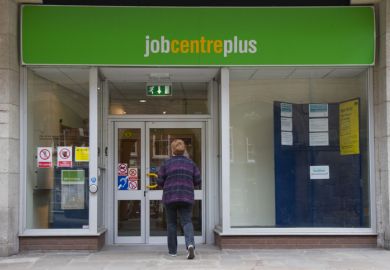Meanwhile, graduates from the Royal Academy of Music, Bishop Grosseteste University and the private University of Buckingham are among those most likely to find a job or to continue their studies.
The Higher Education Statistics Agency today published figures on employment rates at UK higher education institutions for 2011-12 graduates. The statistics are based on the Destinations of Leavers from Higher Education survey of graduates.
Across the sector, 90.8 per cent of full-time first-degree leavers were in employment and/or further study six months after graduating.
The lowest five institutions on Hesa’s employment indicator were London South Bank (77.4 per cent of graduates in a job or further study six months after graduating), the University of East London (79.4 per cent), the University of Bolton (81.1 per cent), Middlesex University (82.3 per cent) and London Metropolitan University (83.3 per cent).
The highest five institutions on the employment indicator were the Royal Academy of Music (100 per cent of graduates in a job or further study six months after graduating), Trinity Laban Conservatoire of Music and Dance (98.9 per cent), the School of Pharmacy (98.2 per cent – the School merged with University College London in January 2012 but still made a separate Hesa return for 2011-12), the Royal College of Music (98 per cent) and Robert Gordon University (97.7 per cent).
The next highest-scoring institutions were Bishop Grosseteste University (97 per cent) and the private University of Buckingham (96.9 per cent).
Anthony Bowne, Trinity Laban principal, said: “The creative world has always been a competitive one, but consistently strong employability figures like ours provide a real sense of confidence for prospective students, parents and teachers.”
In the Hesa figures, institutions are also given individual benchmarks for their graduate employment performance. Hesa explains that the benchmark is a “sector average adjusted for the type of institution in question. The benchmarks are not government targets or quotas.”
The institution that was furthest below its benchmark was London South Bank, followed by Bolton, the University of the West of Scotland, Teesside University and the Royal Veterinary College.
The institution that was farthest ahead of its benchmark was the Royal Academy of Music, followed by Trinity Laban, Ravensbourne, the Royal College of Music and Arts University Bournemouth.
Register to continue
Why register?
- Registration is free and only takes a moment
- Once registered, you can read 3 articles a month
- Sign up for our newsletter
Subscribe
Or subscribe for unlimited access to:
- Unlimited access to news, views, insights & reviews
- Digital editions
- Digital access to THE’s university and college rankings analysis
Already registered or a current subscriber? Login




